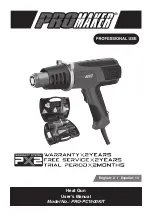
REMOVING PAINT - WINDOW
FRAMES
WARNING – Glass can break
easily when heated.
1. Use the glass protection nozzle.
2. Ensure the nozzle is facing the
correct way to deflect heat away
from the glass before you switch
on the heat gun.
3. Rotate the gun/nozzle 90º as you
move to horizontal or
vertical bead.
4. Paint can be removed by using a
shavehook and/or a soft,
wire brush.
DEFROSTING FROZEN PIPES
WARNING – Do not attempt to
defrost PVC pipes. Always check
that it is a water pipe and not a
gas pipe. Never heat a gas pipe.
1. Choose the hook nozzle and fit
over the heat outlet.
2. Always heat from one or other
end of the frozen portion, not
from the middle.
SHRINK SEALING ELECTRICAL
CABLES
1. Choose the hook nozzle and fit
over the heat outlet.
2. Select a suitably sized, heat
shrinkable sleeve.
3. Evenly heat the sleeve over the
electrical cable.
WELDING PLASTICS
WARNING – Plastic can very
quickly change from being tacky
to becoming liquid. Beware of
burns from hot plastic. Do not
remove molten plastic from a
burn. Run under cold water and
seek medical advice.
1. Choose the concentrator or
deflector nozzle and fit over the
heat outlet.
2. The materials being welded must
be of exactly the same type
of plastic.
3. The areas being welded must be
clean and grease-free.
4. Heat the seam until the plastic
becomes tacky, then apply the
other surface.
BENDING PLASTIC TUBE
WARNING – Protect hands
from heat.
1. Choose the hook nozzle and fit
over heat outlet.
2. Turn the gun upside down and
place on its clip stand so it is
resting on a secure surface with
the nozzle pointing upwards
(see picture below).
3. To avoid buckling or kinking the
tube, fill the tube with dry sand
and seal at both ends.
4. Heat the tube evenly by moving
from side to side and bend to
required shape.
5
Hook Nozzle
• Disperses
the heat flow
evenly around
the whole
work surface.
• Ideal for
defrosting
frozen pipes,
soldering pipe work, bending
plastics or heat shrinking
electrical parts.
Shavehooks
1. Select the required blade.
2. Take the shavehook handle from
the set, remove the nut from the
end and fit the required blade.
3. Fix in place by refitting and
tightening the nut.
Use the:
•
Triangular shavehook
for
stripping
paint from
flat, wooden
surfaces and
edges.
•
Combination
or Heart
shavehook
for mouldings
in convex or
concave
profiles.
Remember to
clean the blade
after use with
wire wool and
lightly oil before
storing.
REMOVING PAINT - GENERAL
Do not heat the paint for too long
as this will burn the paint,
making it difficult to remove.
1. Choose the required nozzle and
fit onto the heat outlet.
2. Hold the gun with nozzle
approximately 50mm (2 inches)
from surface of paintwork.
3. Starting with the low heat setting,
move the gun slowly backwards
and forwards until the paint
blisters and bubbles.
4. Immediately remove the paint
with a scraper or shavehook.
5. Aim to heat the paint just ahead
of the scraper so that you can
develop a continuous action.
Most stickers can also be removed
from paint work by using the heat to
soften the adhesive. Be careful not
to direct the heat for too long if you
are trying to just remove the
stickers as this will blister the paint.
4
Hook Nozzle
Triangular Shavehook
Combination Shavehook
Assembly of Shavehook
Bending Plastic
Tubing
Heart Shavehook
G73 08-08:G30 09/05.qxd 6/8/08 11:10 Page 4























